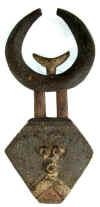 |
 |
TRIBAL AFRICAN ART
KULANGO (KOULANGO, PAKALA)
Côte d'Ivoire
The
190,000 Kulango occupy a region in the Northwest Côte d'Ivoire that borders
Burkina Faso (to the north) and Ghana (to the east). The Kulango are matrilinear. They live
in villages where family property is set according to lineage lines. The elders direct
community life, based around the agricultural calendar. In the past, from the seventeenth
century until the Mandingo invasions, a Kulango king, installed at Bouna, ruled the
kingdom for better or for worse through the mediation of princely families. His power was
primarily felt in Bouna, a booming center of commerce dominated by Diula merchants.
Following the conquest by the Mandingo, the monarchy was significantly diminished,
rebounding in a final gasp as a tool of French colonial administration. Large migrations
of Akan (seventeenth century) and Lobi (nineteenth century), coming from the east and
north, also destabilized Kulango cultural unity. At present, the Kulango share numerous
institutions and characteristics with ethnic groups, which, in search of arable ground,
have gradually come to settle in the region. The once fertile Kulango region has
become almost entirely bush; therefore, the Kulango and other groups in the region are
migrating southward in search of new farmland. When a man finds a plot he wishes to farm,
he settles there and works until he has earned enough money to build a house for his
family, who then joins him. Some of the Kulango have moved to the cities and found
wage-paying jobs as mechanics, taxi drivers, or office clerks.
Each Kulango
village is made up of several small settlements. The settlements consist of a number of
mud huts with cone-shaped roofs made of palm leaves or thatch. The huts are grouped around
a center court, which serves as a meeting place. Every settlement is made up of several
extended families, each of which is its own economic unit. The male head of each extended
family is responsible for offering sacrifices to the ancestral spirits. He is succeeded by
his oldest sister's eldest son. All disputes and community affairs are handled by the
village headmen and the religious chief. Throughout the centuries, Dyula Muslim traders
have come into the Kulango region with the intention of converting the locals to Islam.
However, the Kulango have resisted, and today, only about 6% of them are Muslim. The
majority (90%) continue to practice their traditional ethnic religions. They believe in a
supreme god who is not worshipped but is addressed in association with "mother
earth." The earth god, Tano, is a god of the whole tribe. There is a shrine
set up for Tano, and a yearly festival is held in his honor. During disasters or hard
times, the Kulango pray to the spirits of their ancestors and make offerings of mashed
yams. The spirits are believed to inhabit certain wild animals as well as various objects
of nature: thunder, lightning, water, etc. The Kulango celebrate many festivals, such as
the annual yam festival. This is a time when parents and children exchange gifts then eat
a meal of mashed yams and soup. There is also a festival for the dead, in which the gods
and ancestors are asked for guidance and prosperity. Dances and singing are part of both
festivals.
Kulango statuary is rare, and often presented as
derived from and strongly influenced by Lobi art. Only characterizations of the stylistic
order allow such a hypothesis to be advanced, as information pertaining to the context of
its use is wanting.